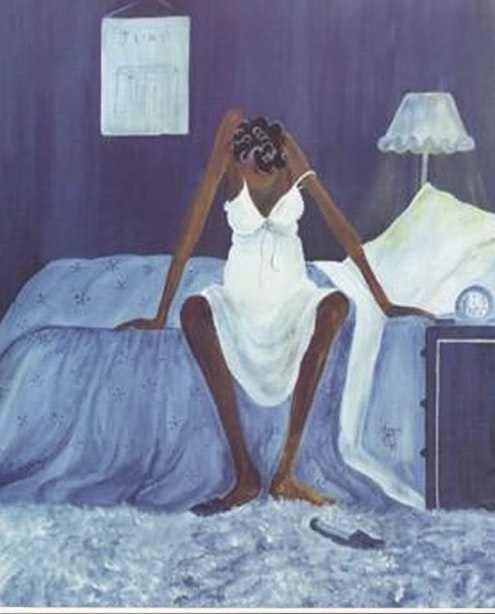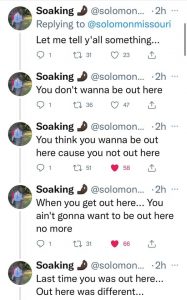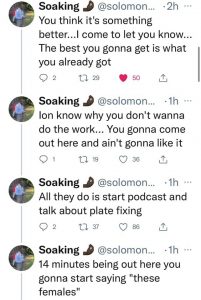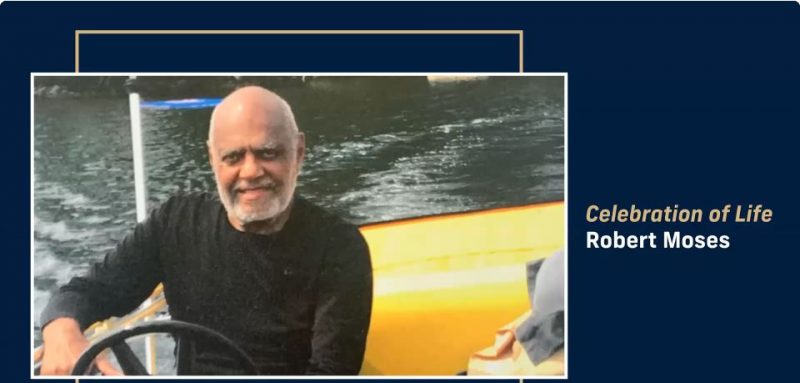Per Bruce Jackson: “In this wonderfully revealing 6-minute interview, the Russian ambassador to Ireland lies, lies, does a bit of slip & slide, and then lies some more. Irish news presenter David McCaullagh calls him on every single one. Now if there were only a brilliant hacker who could slip this into the Fox news feed while Tucker Carlson is doing his nightly Putin-suck….”
 Various Authors
Various Authors
Putin (with Stooge) vs. Navalny
Since I haven't found an English version online, I've added subtitles to Putin's humiliation of his spy chief during today's grotesque security council meeting in the Kremlin. pic.twitter.com/bFx25nWzTK
— Peter Liakhov (@peterliakhov) February 21, 2022
Gifts of the Spirit: Robert Farris Thompson on Basquiat and Haring
This Q&A with Robert Farris Thompson was originally posted at the Sotheby’s website in 2020, when the auction house was charged with selling paintings given to Thompson by Jean-Michel Basquiat and Keith Haring.
Toni Cade Bambara’s Memoir: An Excerpt from “Working At It in Five Parts”
Toni Cade Bambara’s “Working At It in Five Parts” is a hidden gem of prismatic self-reflection that we were surprised to find collecting dust in the Spelman College Archives along her voluminous letters, story drafts, teaching lesson plans, and much more.
“My Heart is in My Ears”: Listening to Jekalyn Carr (et al.)
“Get in your right posture!” Per Ms. Carr as she wails and falls down for her savior. God knows we should all take a knee for her — and her Sister Charisse. (I hear that Youtube commenter: “Why ain’t nobody talking about how ms charisse killed it. lord her voice is heavenly.” No doubt! She made Jekalyn JUMP!)
Jekalyn Carr and Ashley Charisse Mackey are major but they’re not too far gone from the small storefront church in Roxane Beth Johnson’s verse…
Poetic Payback
Martín Espada’s Floaters has won a National Book Award. What follows are poems from the book — along with an intro and a few echoes — originally posted here last spring.
Hunter Gets Captured by the Game
Hunter Harris: “Me after spending a week thinking about the fallout from Nicki Minaj’s cousin’s cheating ass friend’s swollen balls”: 
Christone “Kingfish” Ingram: Straight Out of Clarksdale
Two tracks off Ingram’s 2021 CD, 662:
Jules Chametzky R.I.P.
This obituary was jointly written by the Chametzky family et al.
Jules Chametzky, a Jewish boy from Brooklyn who drew on his background in multi-ethnic 20th century New York to fashion a scholarly and civic career that spanned seven decades and two continents, died Thursday September 23 in Amherst, Massachusetts, to which he had moved in 1958. He was 93.
After the Fall
First’s original editors, longtime New Yorkers, were fully alive to experiences of love and death on 9/11. We printed a set of responses to the attacks that implicitly contradicted those who assumed “anti-Americanism is a necessity” (without imposing a patriotic litmus test). Our post-9/11 issue featured red, white and blue colors above the fold, though that wasn’t a simple flag-waving gesture. The exemplary citizens (and New Yorkers) invoked on our cover were Latin Americans and an Afro-American: La Lupe, Eddie Palmieri and Jay-Z.
I’m reminded of how our colors seemed out of time to the all-knowing Left when I listen to commentary by pundits like Mehdi Hasan who link the post-9/11 “War on Terror” with l/6. That tendentious timeline all but erases the threat once posed by radical Islamists. It assumes American Islamophobia/xenophobia was always a scarier thing than Islamofascism. (I wonder if Mehdi Hasan noticed what happened to Samuel Paty—the French middle school teacher who was decapitated last October after he dared to teach his students about the Charlie Hebdo murders.) While it’s probably true the threat to Americans and Europeans from Islamist terrorists has diminished in recent years, that’s due largely to those Kurdish fighters who turned the tide against ISIS at the battle of Kobani. Future historians may come to see the Kurds’ victory there in January 2015 as the true culmination of the war that blew up in America on 9/11. The Kurds certainly grasped the meaning of their victory: “The battle for Kobani was not only a fight between the YPG and Daesh [ISIS], it was a battle between humanity and barbarity, a battle between freedom and tyranny, it was a battle between all human values and the enemies of humanity.” The clarity of these (mainly Muslim) soldiers who beat an international army of Islamists underscores the not-knowingness of Mehdi Hasan et al.
The following set of posts—by Donna Gaines, George Held, Hans Koning, Wendy Oxenhorn, Fredric Smoler, Laurie Stone, Kurt Vonnegut, and Peter Lamborn Wilson—mixes pieces from First‘s back pages with writing by authors who published their first thoughts on 9/11 in other places. B.D.
Presente: The Eternal Alina Sanchez
Per the Emergency Committee of Rojava: “This month has been a difficult one for the people of Rojava, as well for Kurdish and Yezidi communities in Turkey and Iraq. Taking advantage of the world’s focus on Afghanistan, Turkey has escalated its attacks against communities struggling for autonomy throughout Kurdistan. But these communities are not simply victims, they are resisting every step of the way and we are standing with them!” To find out how can you act in solidarity with the Rojava, please visit the Emergency Committee’s website here.
What follows is a tribute to Dr. Alina Sanchez — a Argentinean doctor and internationalist who went to Rojava in 2011 in search of a truly free society. Committed to the Kurds’ fight against ISIS and Erdogan’s Turkey, she died in an accident there in 2018. It seems right to summon up her life as First upholds the legacy of Sam Dolgoff. There’s a pretty direct ideological link between these two freedom-lovers. Rojava’s Kurds have been inspired by the work of Murray Bookchin — a close comrade of Dolgoff’s (though they had a falling out). Along with blueprints (and disputes) about the workings of a humane society, Dolgoff and Dr. Sanchez shared a soulful worldliness.
The following film tribute starts off in medias res, but you’ll find your footing quickly if you stick with it. (Click on “Read More” below to see it bigger.)
Reconsider Baby
Dell Curry is divorcing his wife of 30+ years and this man aims to help (“Do you like Tumeric??? Charcoal Ice Cream??? You better learn to like it.”)


Got To Be Real

Click HERE to watch the Zoom tribute to Bob Moses hosted by Florida International University, with the participation of the Moses family. (There will be another homegoing ceremony in Cambridge in September.)
The presence of figures from FIU and Broward County’s public school system spoke to the Moses family’s will to keep on pushing the Algebra Project’s program in Southeast Florida. The AP has been integrated into FIU and Broward schools for over a decade and the Moses memorial became another occasion to strengthen institutional connections. (The AP/Broward County link is one more sign of Moses’s instinct to go where America Dilemmas are right in your face. The Broward County School Board is currently resisting Governor DeSantis’s threat to withhold salaries from administrators and teachers who enforce mask mandates.)
Bob Moses’s daughter, Maisha (who Zoomed in at 10:30), and his wife, Janet (who joined around 1:14:45), gave clear-eyed (if sometimes tearful) testimony, fusing kin-folk truths and the book of Curtis Mayfield with The Autobiography of a Yogi and musings of Movement elders. Informed by organizers’ imperatives, their tales of Moses’ life in struggle steered listeners out of doomy darkness. The way forward came into focus for me when another speaker, Whitney Brakefield, made the Moses family’s sense of what’s possible real. Ms. Brakefield instantiated an American future that might seem unimaginable, until you hear her. (She zoomed at 52:25.)
Eliminating Caste in America’s Classrooms (A National Consensus Project Working Paper)
I. America’s caste system depends on caste in classrooms
The idea that America’s schools level the playing field for America’s children is a myth. The playing field has always been sharply tilted–or even completely walled off–to make it easier for the children of affluent families to inherit superior caste status. Even after Brown v. Board of Education, schools are where lower caste students–those with darker-skin and those living in poverty–are taught their subordinate place in U.S. society and in the U.S. economy.
Radical Equations
When Bob Moses died last Sunday, Taylor Branch–author of America in the King Years–pointed out on Twitter that Moses was a student of the Constitution.
Seeing Is Believing
Last month I got a lift when I learned Blue Collar–Paul Schrader’s 1978 movie about working class lifers and union corruption–unsettled a group of middle class city kids who’d never seen the inside of a factory. Their weightier-than-woke response to a screening of the movie in NYC hints it remains a model of popular realist art.
Are You Ready for the Country?
A conversation between Benj DeMott and Celeste Dupuy-Spencer about her painting of the Capitol riot, America’s politics of culture, Christianity and Country music…
Act of Imagination (& Larceny)
The groove in the Rolling Stones’ classic cover of “Just My Imagination” (1978) comes straight out of Waylon Jennings’ “Are You Sure Hank Done It This Way” (1975). No plaints here. Geniuses steal. Follow the echoes below…
Driving While Brown: Stories from the Struggle Against Sherriff Joe Arpaio
Journalists Terry Greene Sterling and Jude Joffe-Block spent years chronicling the human consequences of Sheriff Joe Arpaio’s lawless approach to immigration enforcement in Maricopa County, Arizona. In Driving While Brown, they tell the tale of two opposing movements that redefined Arizona’s political landscape—the restrictionist cause embraced by Arpaio and the Latino-led resistance that rose up against it.
What follows is a Q&A with the authors of Driving While Brown.
